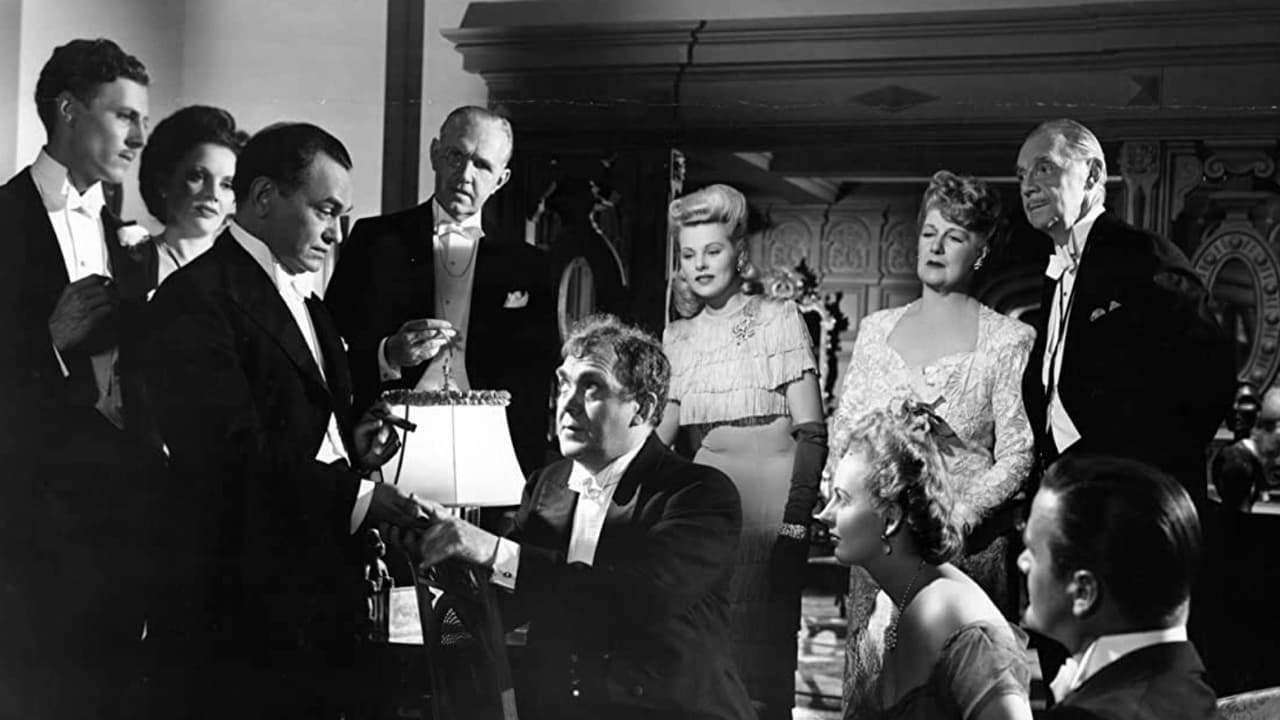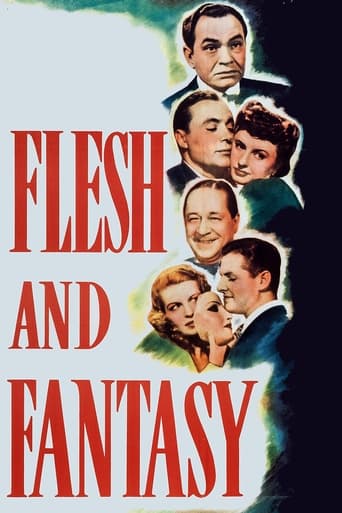ada
the leading man is my tpye
Beystiman
It's fun, it's light, [but] it has a hard time when its tries to get heavy.
Kidskycom
It's funny watching the elements come together in this complicated scam. On one hand, the set-up isn't quite as complex as it seems, but there's an easy sense of fun in every exchange.
Scotty Burke
It is interesting even when nothing much happens, which is for most of its 3-hour running time. Read full review
writers_reign
Julien Duvivier was not only one of the best Directors who ever came out of France but also one of the most versatile being more than adept in several genres. Try telling that to Hollywood: Having prevailed upon him to remake his masterpiece Un Carnet de bal as Lydia they next got him to follow it with Tales Of Manhattan and then yet another episodic piece Flesh and Fantasy. To dispense with pedantry first of all; it seems that one reviewer mistakenly attributed the second segment to Noel Coward when it was, of course, the work of Oscar Wilde; in correcting the initial reviewer the person who did so claimed erroneously that both Wilde and Coward were English and gay; only 50 per cent of that statement is true; Oscar Wilde was Irish, a native of Dublin, who settled in England. Stuff like this tends to distract from the film which, in this case, is as good as one might suppose with anything to which the name Duvivier is appended. There are three basic segments linked loosely by Robert Benchley anchored in a Gentlemen's Club more than likely located in Pall Mall. The first segment reunites Robert Cummings and Betty Field who had starred the year before in a similar multi-storied adaptation King's Row; Field plays the Ugly Duckling who convinces Cummings via a little sleight-of-hand that she is a Swan. The second segment finds Edward G. Robinson initially bemused then increasingly terrified by a palmist's prediction that he will commit murder whilst the final segment sees tightrope walker Charles Boyer dreaming of falling from the high wire watched by a Barbara Stanwyck he has yet to meet. None of the segments is especially original but the combination of stylish direction and fine acting lifts it out of the rut.
Pamela-5
The second of the three tales in this movie is, indeed, the strongest, and the most memorable.Another reviewer wrote that Noel Coward wrote the second of the three mini-movies within this one movie. Not so!!! It was based on an 1891 Oscar Wilde tale called "The Crime of Lord Arthur Saville." Although both gentlemen were British, both writers, both gay, Coward was born at about the time Wilde was sentenced to jail and later died, so the times in which they lived were very different! Plus, obviously, their styles of writing are very different.Just a little film history about the second tale:made into a U.S. theatrical movie in 2006 ("First Snow"); made into a Russian TV movie ("Prestuplenie lorda Artura") in 1991; made into a French TV movie in 1968 ("Le Crime de Lord Arthur Saville"); made into a British TV movie in 1960; made into a U.S. TV episode of "Suspicion" in 1958; enfolded into a theatrical movie in the U.S. in 1943 ("Flesh and Fantasy") made into a theatrical movie in France in 1921 or 1922.Enjoy!
luciferjohnson
A charming "anthology" motion picture, of the kind that was briefly popular in the 1940s. This one contains three stories, each of a supernatural bent. None really brilliant, but diverting.The second piece was the best. This was based on a story by Oscar Wilde (not Noel Coward, as incorrectly stated in another review). Edward G. Robinson plays a lawyer haunted by a prediction that he will murder someone, and the always-watchable Thomas Mitchell is the palm-reader.The first, with Robert Cummings and Betty Field in a story set in the Mardi Gras, is appealing in a naive way. The third segment, set in a circus, is the weakest. Charles Boyer an acrobat? No way.This movie suffers somewhat from some of the most unconvincing studio-bound "locations" I have ever seen. I know, this was the 1940s and all that, made in the middle of the war, but puh-lease!
telegonus
Flesh and Fantasy is a rare forties Hollywood attempt at an art film, and while I cannot say it's wholly successful, it's a good try. Directed by the highly esteemed French director Julian Duvivier and produced by the highly esteemed French actor Charles Boyer, it consists of three stories of the supernatural, told to Robert Benchley, in a framing device, in what appears to be a men's club. The first tale concerns a homely girl who is turned beautiful by the power of a mask sold to her by a strange little shopkeeper. It's a slight, lovely fable, well-acted by Betty Field and Bob Cummings. In the second story we find Edward G. Robinson in London, where a fortune teller reveals to him a fate he tries vainly to escape. The third segment, despite the presence of Charles Boyer and Barbara Stanwyck, is rather mediocre, and concerns predictions in a circus setting. Of these three tales the middle one, an adaptation of an Oscar Wilde story, is by far the best; it is also visually the most appealing. Duvivier brings a Gallic gentility to the film, and his compositions are excellent and always fastidious. One gathers that the movie must have been a labor of love for producer Charles Boyer. All the actors are in top form, and the picture does not at all feel like a product of the Universal studio of this period. Flesh and Fantasy is one of several wartime movies that dealt with the issues of death and fate, which were obviously hanging heavier than unusual on peoples' minds in those days. Off the top of my head I can think of Here Comes Mr. Jordan, I Married a Witch, A Guy Named Joe, Between Two Worlds, The Uninvited and The Picture Of Dorian Gray. Death, rather than dying, was a feature of most such films, which as a rule steered clear of anything grisly, which is to say reminiscent of battlefields. Flesh and Fantasy is quite good at this. With its soft chairs, cobbled streets and a convincing London bridge thrown in for good measure, it makes facing up to one's fate feel as comfortable and delicious a proposition as attending a masquerade ball.

